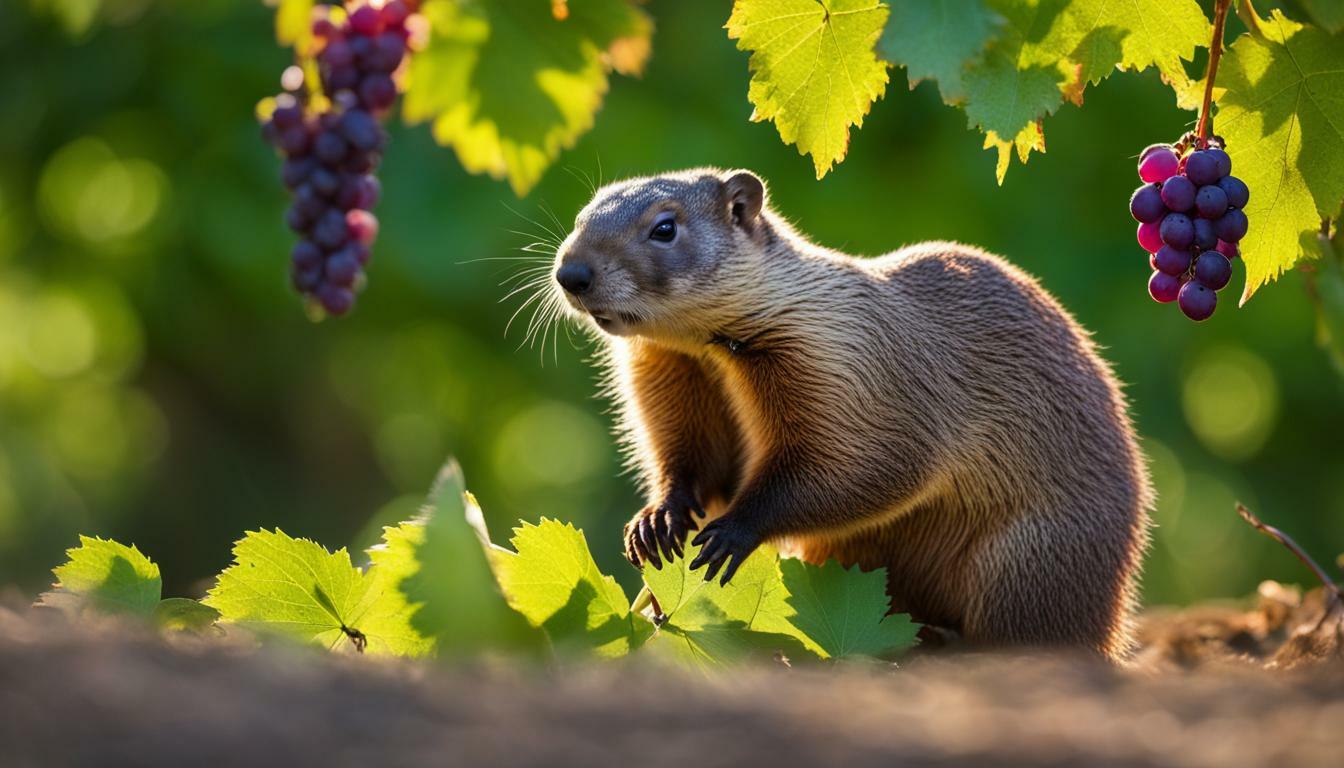If you’ve ever wondered if groundhogs can enjoy grapes as part of their diet, you’ve come to the right place. Groundhogs are known to have a varied diet and are not picky eaters. While grapes may not be their favorite food, they can indeed eat them. Groundhogs primarily consume vegetation such as lettuce, alfalfa, daisies, and dandelions. They also enjoy various fruits like apples, cherries, and berries. Additionally, groundhogs may include insects like June bugs, snails, and grasshoppers in their diet. However, they tend to avoid acidic fruits like pineapples, lemons, limes, grapefruits, and avocados. They also steer clear of tart fruits like cranberries and fruits with tough exteriors such as pomegranates and mangoes. On rare occasions, groundhogs may consume small animals like juvenile birds.
Key Takeaways:
- Groundhogs can eat grapes, but they may not be their favorite food.
- They have a varied diet and are not picky eaters.
- Groundhogs primarily consume vegetation like lettuce, alfalfa, daisies, and dandelions.
- They also enjoy fruits such as apples, cherries, and berries.
- Groundhogs may include insects like June bugs, snails, and grasshoppers in their diet.
Groundhog Diet: A Varied Mix of Vegetation and Fruits
Groundhogs have a diverse diet, which includes a mix of vegetation and fruits that they consume. They are known to be opportunistic eaters and are not particularly selective when it comes to their food choices. While groundhogs primarily feed on vegetation, they also enjoy indulging in a variety of fruits.
Vegetation in a Groundhog’s Diet
When it comes to vegetation, groundhogs have quite a appetite. They often munch on plants such as lettuce, alfalfa, daisies, and dandelions. These leafy greens provide essential nutrients and fiber that contribute to their overall health and well-being. Groundhogs are frequently seen grazing in meadows and fields, enjoying the abundance of vegetation available.
Fruits that Groundhogs Enjoy
In addition to their love for vegetation, groundhogs also have a soft spot for fruits. They delight in feasting on a variety of fruits, including apples, cherries, and berries. These juicy treats not only provide them with essential vitamins and minerals but also satisfy their natural cravings for sweetness.
| Vegetation | Fruits |
|---|---|
| Lettuce | Apples |
| Alfalfa | Cherries |
| Daisies | Berries |
| Dandelions |
However, it’s important to note that groundhogs tend to prefer ripe and softer fruits over unripe ones. They may not be particularly fond of acidic fruits like pineapples, lemons, limes, grapefruits, or avocados. Additionally, they may steer clear of tart fruits like cranberries and fruits with tough exteriors such as pomegranates and mangoes.
While vegetation and fruits make up the majority of a groundhog’s diet, they may also occasionally include insects in their meals. June bugs, snails, and grasshoppers are a few examples of the insects groundhogs may consume. Furthermore, groundhogs have been observed feeding on small animals like juvenile birds, albeit infrequently.
So, if you’re wondering what to feed a groundhog, keep in mind their preference for a varied mix of vegetation and fruits. Providing them with a well-balanced diet that includes leafy greens and a variety of ripe and soft fruits will keep them happy and healthy.
Vegetation in a Groundhog’s Diet
Groundhogs are known to devour various types of vegetation, including lettuce, alfalfa, daisies, and dandelions. These leafy greens are a staple in their diet and provide the necessary nutrients and fiber for their well-being. Lettuce, with its crisp and refreshing leaves, is a preferred choice for groundhogs. They also have a taste for alfalfa, a nutrient-rich plant that aids in digestion.
Groundhogs have a fondness for daisies and dandelions, both of which are commonly found in meadows and fields. These yellow flowers not only add color to their diet but also offer a variety of nutrients. Groundhogs are meticulous eaters, often selecting the finest parts of these plants while discarding the rest.
Here is a table summarizing the vegetation that groundhogs commonly consume:
| Vegetation | Description |
|---|---|
| Lettuce | Crunchy and refreshing leaves |
| Alfalfa | Nutrient-rich and aids digestion |
| Daisies | Yellow flowers found in meadows |
| Dandelions | Yellow flowers commonly seen in fields |
While groundhogs primarily rely on vegetation, they do have a diverse palate and enjoy the taste of various fruits as well. Let’s take a closer look at the fruits groundhogs delight in and those they tend to avoid in the next section.
Fruits that Groundhogs Enjoy
When it comes to fruits, groundhogs have a particular fondness for apples, cherries, and berries. These juicy treats are among their favorites and provide a refreshing addition to their diet. Groundhogs are known to enjoy the sweet flavors and natural sugars found in these fruits, making them a delicious snack option.
Groundhogs also appreciate the variety that fruits offer. Apples, with their crunchy texture and sweet taste, are often relished by these furry creatures. Likewise, cherries and berries, such as strawberries and blueberries, are popular choices due to their vibrant colors and enticing flavors.
While groundhogs may feast on these fruits when available, it is important to note that fruit consumption is not the primary component of their diet. Groundhogs mainly rely on vegetation for their nutritional needs. Nonetheless, offering them fruits as occasional treats can provide enrichment and diversity to their diet.
| Fruits that Groundhogs Enjoy | Prevalence |
|---|---|
| Apples | High |
| Cherries | Moderate |
| Berries (strawberries, blueberries) | Moderate |
While groundhogs have a fondness for certain fruits, there are some types that they tend to avoid. Acidic fruits like pineapples, lemons, limes, grapefruits, and avocados are not typically a part of their diet. The same applies to tart fruits like cranberries. Additionally, groundhogs are naturally inclined to steer clear of fruits with tough exteriors, such as pomegranates and mangoes.
In conclusion, groundhogs can eat grapes, but they are not their preferred fruit. Apples, cherries, and berries are among the fruits that groundhogs enjoy the most, relishing their flavors and natural sweetness. However, it is important to remember that fruits should only be a supplementary part of their diet, with vegetation being their primary source of nutrition.
Can Groundhogs Eat Grapes?
Yes, groundhogs can eat grapes, although they may not be their top choice of fruit. These furry creatures have a varied diet and are not picky eaters. While they primarily munch on vegetation like lettuce, alfalfa, daisies, and dandelions, they also enjoy snacking on various fruits such as apples, cherries, and berries.
However, groundhogs do have some preferences when it comes to fruits. They are not likely to indulge in acidic fruits like pineapples, lemons, limes, grapefruits, or avocados. These tart flavors may not appeal to their taste buds. Similarly, groundhogs tend to avoid fruits with tough exteriors like pomegranates and mangoes.
In addition to their plant-based diet, groundhogs may occasionally include insects in their meals. June bugs, snails, and grasshoppers can find themselves on the menu. These critters may also venture into eating small animals like juvenile birds, but this is not a common occurrence.
| Fruits Groundhogs Enjoy: | Fruits Groundhogs Avoid: |
|---|---|
| Apples | Pineapples |
| Cherries | Lemons |
| Berries | Limes |
| – | Grapefruits |
| – | Avocados |
In conclusion, while grapes are not the preferred fruit for groundhogs, they can still be part of their diet. These furry creatures have a broad appetite, enjoying a variety of vegetation and fruits. So, if you happen to spot a groundhog snacking on grapes in your garden, it’s not something you need to worry about.
Groundhogs and Acidic Fruits
Groundhogs generally steer clear of acidic fruits such as pineapples, lemons, limes, and grapefruits. These fruits tend to have a high acidity level, which can cause digestive issues for groundhogs. While groundhogs are known to have a varied diet, they prefer fruits that are sweeter and less acidic.
Acidic fruits may not sit well with a groundhog’s sensitive digestive system. Consuming too many acidic fruits can lead to stomach discomfort and potentially harm their overall health. That’s why groundhogs tend to avoid these types of fruits.
Instead, groundhogs opt for safer and more palatable options like apples, cherries, and berries. These fruits provide a good balance of sweetness and nutritional value for groundhogs. They are not only enjoyable for groundhogs to eat but also provide important vitamins and antioxidants that contribute to their overall health and well-being.
| Fruits Groundhogs Enjoy |
|---|
| Apples |
| Cherries |
| Berries |
It’s important to understand a groundhog’s dietary preferences and provide them with the appropriate foods. Offering a variety of safe fruits and vegetables can help ensure their nutritional needs are met. While groundhogs may not be interested in acidic fruits, there are plenty of other options available to keep them happy and healthy.
Groundhogs and Tart Fruits
Tart fruits like cranberries are not commonly on the menu for groundhogs. These furry creatures have a varied diet that primarily consists of vegetation and fruits. While groundhogs are known to enjoy a range of fruits like apples, cherries, and berries, tart fruits like cranberries don’t seem to appeal to their taste buds. Unlike some other animals, groundhogs tend to stay away from the sourness of cranberries.
Groundhogs have their own dietary preferences, and their avoidance of tart fruits may be attributed to their natural instincts. Groundhogs are herbivores and prefer foods that are sweet or mild in flavor. This is why they are more likely to indulge in the sweetness of apples or cherries rather than the tartness of cranberries.
When it comes to their diet, groundhogs also tend to avoid fruits with tough exteriors like pomegranates and mangoes. These fruits may be more challenging for groundhogs to consume compared to softer fruits. They are more inclined to opt for fruits that are easier to eat and provide them with the necessary nutrients.
Groundhog Dietary Tips
- Offer a variety of vegetation: Provide groundhogs with a mix of their favorite vegetation, such as lettuce, alfalfa, daisies, and dandelions.
- Include a selection of fruits: Offer groundhogs fruits like apples, cherries, and berries to give them a sweet and nutritious treat.
- Avoid acidic and tart fruits: Groundhogs are less likely to eat fruits that are acidic, tart, or have tough exteriors. Stick to fruits they enjoy, and avoid pineapples, lemons, limes, grapefruits, cranberries, pomegranates, mangoes, or avocados.
- Supplement with insects: While not a staple in their diet, groundhogs may occasionally consume insects like June bugs, snails, and grasshoppers. However, make sure these insects are safe and free from pesticides or other harmful substances.
- Provide a balanced diet: Ensure that groundhogs have access to a balanced diet that includes a mix of vegetation, fruits, and occasional insects. This will help meet their nutritional needs and promote overall health.
Groundhogs have unique dietary habits, and while tart fruits like cranberries may not be their preferred choice, they still enjoy a range of other fruits and vegetation. By understanding their dietary preferences and offering a balanced diet, you can ensure that groundhogs stay healthy and well-nourished.
| Preferred Foods | Avoided Foods |
|---|---|
| Apples | Pineapples |
| Cherries | Lemons |
| Berries | Limes |
| Lettuce | Grapefruits |
| Alfalfa | Cranberries |
| Daisies | Pomegranates |
| Dandelions | Mangoes |
Groundhogs and Fruits with Tough Exteriors
Groundhogs typically avoid fruits with tough exteriors, including pomegranates and mangoes. These hard-shelled fruits can be challenging for groundhogs to consume due to their size and tough skin. While groundhogs have strong jaws and teeth, they prefer fruits that are easier to bite into and have a softer texture.
Instead, groundhogs tend to favor fruits with a more delicate and fleshy exterior, such as apples, cherries, and berries. These fruits provide a more palatable experience for groundhogs and are easier for them to consume. Groundhogs have a varied diet and will often seek out a mix of vegetation and fruits to meet their dietary needs.
It’s important to note that fruits should only be offered to groundhogs in moderation and as part of a balanced diet. While fruits can be a tasty treat for these furry critters, their main diet consists of vegetation. Offering a diverse range of vegetables like lettuce, alfalfa, daisies, and dandelions is crucial to ensure their nutritional requirements are met.
| Fruits groundhogs enjoy | Fruits groundhogs avoid |
|---|---|
| Apples | Pomegranates |
| Cherries | Mangoes |
| Berries |
While groundhogs may have some preferences when it comes to fruits, they are generally not picky eaters. They adapt to their environment and consume a variety of foods. It’s always best to provide a balanced diet for these creatures, ensuring they have access to a mix of vegetation, fruits, and occasional insects.
Conclusion
Groundhogs have a diverse diet that includes vegetation, fruits, and occasionally insects. While they may avoid fruits with tough exteriors like pomegranates and mangoes, they enjoy a wide range of other fruits such as apples, cherries, and berries. It’s important to offer groundhogs a balanced diet that meets their nutritional needs and provides them with enough variety to thrive.
Remember, if you’re considering feeding groundhogs, always do so in moderation and consult with experts or local wildlife organizations to ensure you’re offering safe foods for them. Respecting their natural dietary habits will help keep these adorable creatures healthy and happy.
Insects in a Groundhog’s Diet
While primarily herbivores, groundhogs may also incorporate insects like June bugs, snails, and grasshoppers into their diet. These occasional sources of protein help supplement their primarily plant-based meals. Groundhogs are opportunistic feeders and will take advantage of the availability of insects in their environment.
Insects can provide groundhogs with essential nutrients and vitamins that may be lacking in their otherwise herbivorous diet. For example, grasshoppers are rich in protein, offering groundhogs a valuable source of energy. Snails, on the other hand, can provide calcium, which is important for maintaining healthy bones and teeth.
It’s important to note that while groundhogs may consume insects, it is not a staple part of their diet. They primarily rely on vegetation and fruits to meet their nutritional needs. However, the inclusion of insects in their diet showcases the adaptability of these animals to make the most of available food sources.
| Types of Insects | Nutritional Benefits |
|---|---|
| June bugs | Protein-rich |
| Snails | Calcium source |
| Grasshoppers | High in protein |
While groundhogs may occasionally snack on insects, it’s important not to rely solely on this food source. Providing a varied diet that includes a mix of vegetation, fruits, and occasional insects will ensure that your groundhog has a balanced and nutritious diet.
Other Animals Groundhogs May Consume
Although not their primary food source, groundhogs have been known to consume small animals such as juvenile birds on occasion. Groundhogs, also known as woodchucks, are primarily herbivores and have a preference for vegetation and fruits. However, in certain circumstances, they may resort to consuming other animals as well.
It is important to note that groundhogs primarily rely on plants in their diet and do not actively hunt or prey on animals. Their feeding habits lean towards eating a variety of vegetation, including lettuce, alfalfa, daisies, and dandelions. These plants provide the necessary nutrients for their overall well-being.
However, there have been instances where groundhogs have been observed consuming small animals, particularly juvenile birds. This behavior is more likely to occur when groundhogs are faced with a scarcity of their usual food sources or when they come across fledglings in their burrows.
| Groundhog Feeding Tips |
|---|
| Provide a diverse range of vegetation and fruits in their habitat to ensure they have enough options in their diet. |
| Supplement their diet with fresh fruits, such as apples, cherries, and berries, to provide additional nutrients and variety. |
| Avoid feeding groundhogs acidic fruits like pineapples, lemons, limes, grapefruits, or avocados as they are not likely to consume them. |
| Keep in mind that groundhogs are more inclined to eat vegetation and fruits, so providing a well-rounded plant-based diet is essential. |
| Ensure their habitat has an ample supply of fresh water, as groundhogs need to stay hydrated. |
While groundhogs consuming small animals is not a common occurrence, providing a balanced and nutritious diet consisting of vegetation and fruits is crucial for their overall health. By offering a variety of food options and following the recommended feeding tips, you can help ensure that groundhogs have a well-rounded and satisfying diet.
Groundhog Dietary Tips
To provide a healthy diet for groundhogs, consider offering a variety of vegetation and fruits that align with their dietary preferences. Groundhogs are not picky eaters and enjoy a mix of plants and fruits in their diet. Vegetation such as lettuce, alfalfa, daisies, and dandelions are great options to include in their meals. These plants provide essential nutrients and help maintain their overall well-being.
In addition to vegetation, offering a selection of fruits can add variety to their diet. Groundhogs particularly enjoy fruits like apples, cherries, and berries. These juicy treats not only provide hydration but also offer essential vitamins and antioxidants.
While groundhogs can eat grapes, they may not be their go-to fruit. It’s important to note that groundhogs tend to avoid acidic fruits like pineapples, lemons, limes, grapefruits, and avocados. They also have a preference for sweeter fruits rather than tart ones, such as cranberries. Furthermore, groundhogs are less likely to consume fruits with tough exteriors like pomegranates and mangoes.
It’s worth mentioning that insects can be a small part of a groundhog’s diet. They may occasionally consume June bugs, snails, and grasshoppers. However, it’s important to ensure that the insects are not treated with any harmful pesticides or chemicals.
| Groundhog Dietary Tips | |
|---|---|
| 1. | Include a variety of vegetation such as lettuce, alfalfa, daisies, and dandelions in their diet. |
| 2. | Offer fruits like apples, cherries, and berries as a delicious and nutritious treat. |
| 3. | Avoid feeding groundhogs acidic fruits like pineapples, lemons, limes, grapefruits, and avocados. |
| 4. | Try to steer clear of tart fruits like cranberries and fruits with tough exteriors like pomegranates and mangoes. |
| 5. | Occasionally supplement their diet with insects like June bugs, snails, and grasshoppers. Ensure the insects are pesticide-free. |
Conclusion
Groundhogs can indeed eat grapes, but their preference may lean more towards other fruits in their varied diet. These creatures are known for having a diverse palate and are generally not picky eaters. Vegetation forms a significant part of their diet, including lettuce, alfalfa, daisies, and dandelions. When it comes to fruits, groundhogs enjoy a range of options such as apples, cherries, and berries.
While groundhogs have a broad dietary range, there are certain fruits they tend to avoid. Acidic fruits like pineapples, lemons, limes, grapefruits, and avocados are not commonly consumed by groundhogs. Similarly, tart fruits like cranberries may not be tempting for these animals. Additionally, groundhogs tend to stay away from fruits with tough exteriors like pomegranates and mangoes.
Although plants dominate their diet, groundhogs may occasionally include insects in their meals. June bugs, snails, and grasshoppers are some examples of insects that groundhogs may consume. Furthermore, groundhogs have been known to eat small animals like juvenile birds, although this is not a regular occurrence.
In conclusion, while grapes are not the top choice for groundhogs, they can certainly be included in their diet. Groundhogs generally have a broad range of plants and fruits that they enjoy, and as long as grapes are given in moderation, they can be a safe and enjoyable treat for these fascinating creatures.
FAQ
Can groundhogs eat grapes?
Yes, groundhogs can eat grapes, although they may not be their favorite food. Groundhogs have a varied diet and are not picky eaters.
What do groundhogs eat?
Groundhogs primarily eat vegetation such as lettuce, alfalfa, daisies, dandelions, and various fruits like apples, cherries, and berries. They may also eat insects like June bugs, snails, and grasshoppers.
Do groundhogs eat acidic fruits?
No, groundhogs do not typically eat acidic fruits such as pineapples, lemons, limes, grapefruits, or avocados.
Do groundhogs eat tart fruits?
Groundhogs tend to avoid tart fruits like cranberries.
Do groundhogs eat fruits with tough exteriors?
Groundhogs are not inclined to eat fruits with tough exteriors like pomegranates and mangoes.
What other animals do groundhogs eat?
While groundhogs primarily consume plants, they may occasionally eat small animals like juvenile birds and insects.
What are some tips for feeding groundhogs?
Provide groundhogs with a balanced diet by offering a mix of vegetation and fruits that they enjoy. Ensure they have access to fresh water and avoid feeding them harmful foods like acidic fruits or toxic plants.




